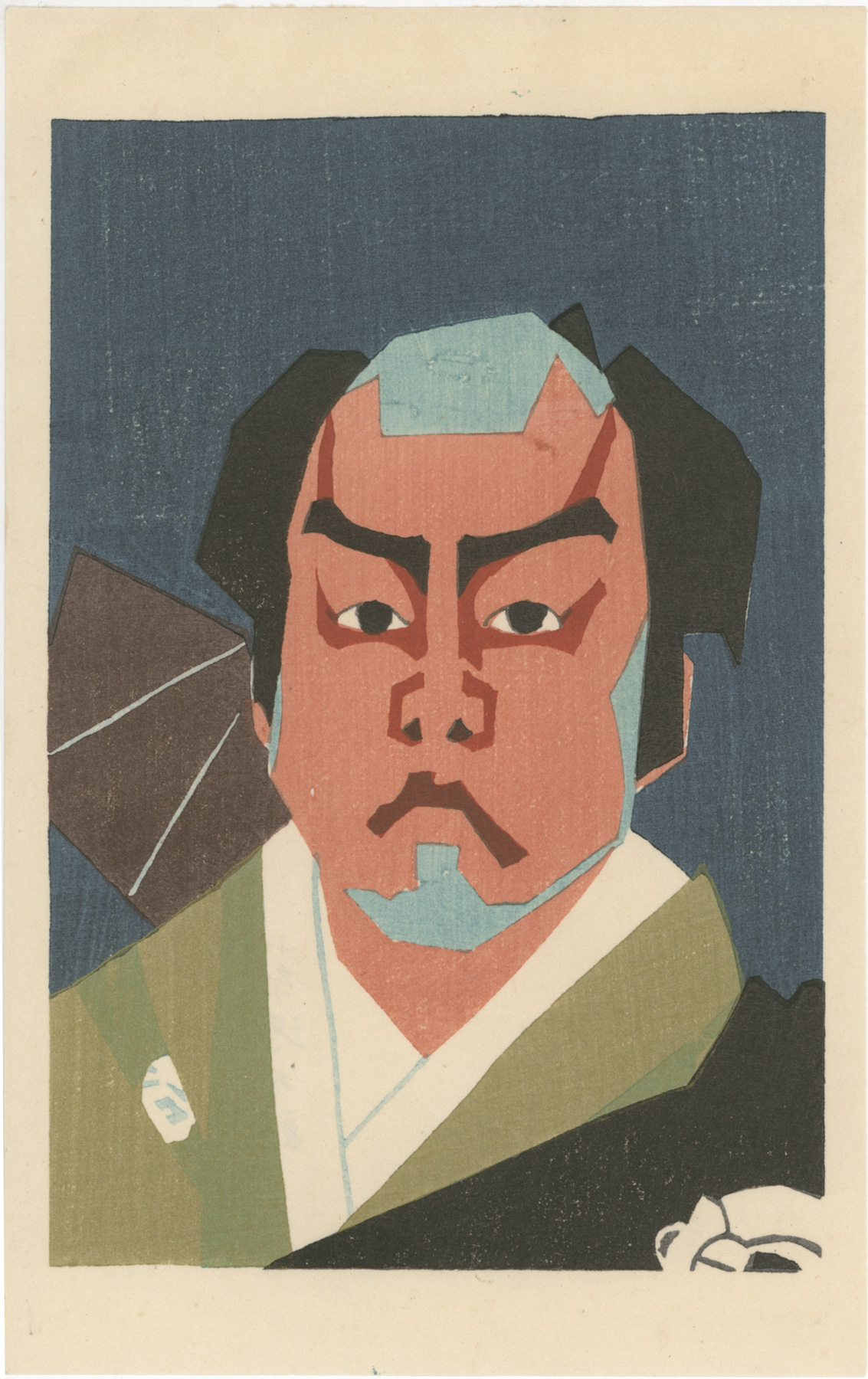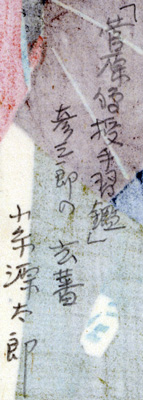About This Print
This small format print was created by Koito Gentarō (1887-1978) for the short-lived 1915 magazine Shin Nigao whose purpose was to advertise the Kabuki theater and renew interest in actor prints. Pictured is the actor Bandō Hikosaburō VI in the role of Genba from the play Sugawara's Secrets of Calligraphy. The print appeared in the fifth and final November 1915 issue of the magazine.
For more information on this short-lived magazine whose purpose was to advertise the Kabuki theater and renew interest in actor prints, see the article Shin Nigao Magazine.
The Actor in this Print
Source: Kabuki Encyclopedia, An English-Language Adaption of Kabuki Jiten, Samuel L. Leiter, Greenwood Press, 1979, p. 23.Bandō Hikosaburō VI 1886-1938
Third son of Onoe KikugorōV, he took the name of Hikosaburō in 1915. He performed chiefly at the Ichimura-za with his brother, the great Onoe Kikugorō VI.
The Play Sugawara Denju Tenarai Kagami (Secrets of Calligraphy)
Source: website of The Virtual Museum of Japanese Arts http://web-japan.org/museum/kabuki/kabuki01/kabuki_01.htmlDuring the power struggle in the Heian era (794-1185), Sugawara-no-Michizane was exiled to Dazaifu for a crime that he had not committed. This tragic incident became a legend and was adopted for various entertainments.
The kabuki play, "Sugawara Denju Tenarai Kagami (Secrets of Calligraphy)" is one of them, however, Michizane is not one of the main characters in the play, these are his triplet sons, Umeomaru (plum tree), Matsuomaru (pine tree) and Sakuramaru (cherry tree). Michizane loses his position because of a rival's machinations and the triplet brothers become embroiled in a fraternal struggle. As a result, Sakuramaru commits "harakiri" and Matsuomaru sacrifices his son.
The playwright's inspiration for the characters of the triplet brothers in this play came from "Triplets born in Osaka" a story of the middle Edo era (1603-1867) which was played against the background of the Heian era.
Print Details
| IHL Catalog | #850 | ||
| Title | Hikosaburō (Genba) 坂東 彦三郎 (玄蕃) (Title is transcribed from the presentation sheet the print was tipped to.) Ichimura-za, November play, Sugiwara's Secrets of Calligraphy, Hikosaburō in the role of Genba. | ||
| Series | Magazine: Shin Nigao (New Portraits) volume 5 新似顔 第一年五編 | ||
| Artist | Koito Gentarō (1887-1978) | ||
| Signature | No signature on print. 小糸源太郎 畫 Koito Gentarō ga printed on bottom of magazine page print was originally tipped to (see Miscellaneous below) | ||
| Seal | not sealed | ||
| Date | November 1915 | ||
| Edition | First and only edition printed in magazine Shin Nigao | ||
| Publisher | Nigaodō 似顔洞 | ||
| Carver and Printer | Igami Bonkotsu (1875-1933) | ||
| Impression | excellent | ||
| Colors | excellent | ||
| Condition | excellent | ||
| Miscellaneous |
| ||
| Genre | shin hanga (new prints); nigao-e | ||
| Format | koban | ||
| H x W Paper | 7 1/4 x 4 5/8 (18.4 x 11.7 cm) | ||
| Collections This Print | The British Museum 1991,1112,0.193.5 (entire magazine, only front cover shown); Art Research Center Ritsumeikan University BM-SJ193-05 (British Museum's copy of entire magazine with all pages shown) | ||
| Reference Literature |
7/25/2020
11/19/2018



